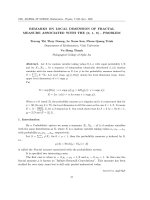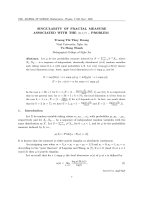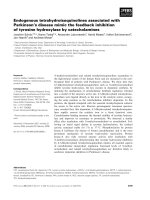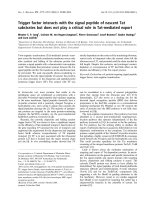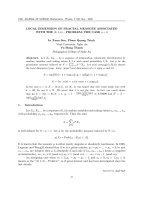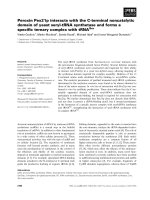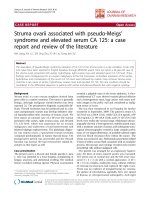Báo cáo " SINGULARITY OF FRACTAL MEASURE ASSOCIATED WITH THE (0, 1, 7) - PROBLEM " potx
Bạn đang xem bản rút gọn của tài liệu. Xem và tải ngay bản đầy đủ của tài liệu tại đây (207.31 KB, 13 trang )
VNU. JOURNAL OF SCIENCE, Mathematics - Physics. T.XXI, N
0
2 - 2005
SINGULARITY OF FRACTAL MEASURE
ASSOCIATED WITH THE (0, 1, 7) -PROBLEM
Truong Thi Thuy Duong
Vinh University, Nghe An
Vu Hong Thanh
Pedagogical College of Nghe An
Abstract.
Let µ be the probability measure induced by S =
∞
n=1
3
−n
X
n
,where
X
1
,X
2
, is a sequence of independent, identically distributed (i.i.d) random variables
each taking values
0, 1,a with equal probability 1/3.Letα(s) (resp.α(s), α(s))denote
the local dimension (resp. lower, upper local dimension) of
s ∈ supp µ,andlet
α = sup{α(s):s ∈ supp µ}; α = inf{α(s):s ∈ supp µ};
E = {α : α(s)=α
for some s ∈ supp µ}
.
In the case
a =3k +1for k =1, E =[1−
log(1+
√
5)−log 2
log 3
, 1], see [10]. It is conjectured
that in the general case, for
a =3k +1( k ∈ N), the local dimension is of the form as
the case
k =1,i.e.,E =[1−
log a
b log 3
, 1] for a, b depends on k. In fact, our result shows
that for
k =2(a =7), we have α =1, α =1−
log(1+
√
3)
3log3
and E =[1−
log(1+
√
3)
3log3
, 1].
1. Introduction
Let X be random variable taking values a
1
,a
2
, ,a
m
with probability p
1
,p
2
, ,p
m
,
respectively and let X
1
,X
2
, be a sequence of independent random variables with the
same distribution as X.LetS =
∞
n=1
ρ
n
X
n
,for0< ρ < 1, and let µ be the probability
measure induced by S, i.e.,
µ(A)=Prob{ω : S(ω) ∈ A}.
It is known that the measure is either purely singular or absolutely continuous.
An intriguing case when m =3, ρ = p
1
= p
2
= p
3
=1/3anda
1
=0,a
2
=1,a
3
= a.
According to the ”pure theorem” of Lagarias and Wang, in [7], if a ≡ 0(mod3)ora ≡ 1
(mod 3) then µ is purely singular.
Let us recall that for s ∈ supp µ the local dimension α(s)ofµ at s is defined by
α(s)= lim
h→0
+
log µ(B
h
(s))
log h
, (1)
Typeset by A
M
S-T
E
X
7
8 Truong Thi Thuy Duong, Vu Hong Thanh
provided that the limit exists, where B
h
(s) denotes the ball centered at s with radius h.If
the limit (1) does not exist, we define the upper and lower local dimension, denoted
α(s)
and α
(s), by taking the upper and lower limits respectively.
Denote
α =sup{α(s):s ∈ supp µ} ; α =inf{α(s):s ∈ supp µ};
and let
E = {α : α(s)=α for some s ∈ supp µ}
be the attainable values of α(s), i.e., the range of function α definning in the supp µ.
In the case a =3k + 1 it is conjectured that the local dimension is of the form as
k =1,itmeansthatE =[1−
log a
b log 3
, 1] for a, b depends on k. Our aim in this note is to
prove that this conjecture is true for k = 2. In fact, our result is the following:
Main Theorem. For a =7wehaveα =1, α =1−
log(1+
√
3)
3log3
and E =[1−
log(1+
√
3)
3log3
, 1].
The paper is organized as follows. In Section 2 we establish some auxiliary results used in
the proof of the Main Theorem. The proof o f the Main Theorem will be given in the last
section.
2. Some Auxiliary Results
Let X
1
,X
2
, be a sequence of i.i.d random variables e ach taking values 0, 1, 7
with equal probabilit y 1/3. Let S =
∞
i=1
3
−i
X
i
, S
n
=
n
i=1
3
−i
X
i
be the n-partial sum
of S, and let µ, µ
n
be the probability measures induced by S, S
n
, respectively. For any
s =
∞
n=1
3
−n
x
n
∈ supp µ, x
n
∈ D: = {0, 1, 7},lets
n
=
n
i=1
3
−i
x
i
be its n-partial
sum. It is easy to see that for any s
n
,s
n
∈ supp µ
n
, |s
n
− s
n
| = k3
−n
for some k ∈ N.
Let
s
n
= {(x
1
,x
2
, ,x
n
) ∈ D
n
:
n
i=1
3
−i
x
i
= s
n
}.
Then we have
µ
n
(s
n
)=#s
n
3
−n
for every n, (2)
where # s
n
denotes the cardinality of set s
n
.
Two sequences (x
1
,x
2
, ,x
n
)and(x
1
,x
2
, ,x
n
)inD
n
are said to be equivalent,
denoted by (x
1
,x
2
, ,x
n
) ≈ (x
1
,x
2
, ,x
n
), if
n
i=1
3
−i
x
i
=
n
i=1
3
−i
x
i
.Wehave
2.1. Claim. (i) For any (x
1
,x
2
, ,x
n
), (x
1
,x
2
, ,x
n
)inD
n
and s
n
=
n
i=1
3
−i
x
i
,
s
n
=
n
i=1
3
−i
x
i
.Ifs
n
− s
n
=
k
3
n
,wherek ∈ Z,thenx
n
−x
n
≡ k (mod 3).
(ii) Let s
n
>s
n
>s
n
be three arbitrary consecutive points in supp µ
n
. Then either
s
n
−s
n
or s
n
−s
n
is not
1
3
n
and either s
n
− s
n
or s
n
− s
n
is not
2
3
n
.
Proof. (i) Since s
n
− s
n
=
k
3
n
,wehave
3
n−1
(x
1
− x
1
)+3
n−2
(x
2
− x
2
)+ +3(x
n−1
− x
n−1
)+x
n
− x
n
= k,
Singularity of Fractal Measure Associated with 9
which implies x
n
−x
n
≡ k (mod 3). The claim (i) is proved.
(ii) We can write
s
n
= s
n−1
+
x
n
3
n
,s
n
= s
n−1
+
x
n
3
n
and s
n
= s
n−1
+
x
n
3
n
,
where s
n−1
,s
n−1
,s
n−1
∈ supp µ
n−1
and x
n
,x
n
,x
n
∈ D. Assume on the contrary that
s
n
−s
n
= s
n
−s
n
=
1
3
n
. Then
s
n−1
− s
n−1
=
1+x
n
− x
n
3
n
=
1+x
n
− x
n
3
1
3
n−1
,
s
n−1
− s
n−1
=
1+x
n
− x
n
3
n
=
1+x
n
− x
n
3
1
3
n−1
.
Since s
k
− s
k
=
t
3
k
,t ∈ Z whenever s
k
,s
k
∈ supp µ
k
, we have (1 + x
n
− x
n
) ≡ 0(mod3)
and (1 + x
n
− x
n
) ≡ 0(mod3). Because(1+x
n
− x
n
) ≡ 0(mod3)andx
n
,x
n
∈ D,we
obtain x
n
=0. Then1+x
n
− x
n
=1+x
n
∈ {1, 2, 8} for any x
n
∈ D, a contradiction.
Similarly, we ha ve either s
n
− s
n
or s
n
−s
n
is not
2
3
n
. The claim (ii) is proved.
2.2. Claim. (i) Let s
n+1
∈ supp µ
n+1
and s
n+1
= s
n
+
0
3
n+1
,s
n
∈ supp µ
n
. We have
#s
n+1
=#s
n
, for every n 1.
(ii) For any s
n
,s
n
∈ supp µ
n
if s
n
− s
n
=
1
3
n
,thenx
n
=0,x
n
=1orx
n
=7and
#s
n
a #s
n
.Ifx
n
=1, then s
n−1
= s
n−1
and if x
n
=7, then s
n−1
= s
n−1
+
2
3
n−1
,
where s
n
= s
n−1
+
x
n
3
n
,s
n
= s
n−1
+
x
n
3
n
and s
n−1
,s
n−1
∈ supp µ
n−1
,x
n
,x
n
∈ D.
(iii) For any s
n
,s
n
∈ supp µ
n
, if s
n
− s
n
=
2
3
n
, then x
n
=0,x
n
=1orx
n
=7.
Moreover, if x
n
=1, then s
n−1
− s
n−1
=
1
3
n−1
and if x
n
=7, then s
n−1
− s
n−1
=
3
3
n−1
,
where s
n
= s
n−1
+
x
n
3
n
,s
n
= s
n−1
+
x
n
3
n
and s
n−1
,s
n−1
∈ supp µ
n−1
,x
n
,x
n
∈ D.
(iv) For any s
n
,s
n
,s
n
∈ supp µ
n
, if s
n
− s
n
=
1
3
n
and s
n
− s
n
=
2
3
n
, then s
n
=
s
n−1
+
1
3
n
= s
∗
n−1
+
7
3
n
and s
n
= s
n−1
+
7
3
n
or s
n
= s
n−1
+
1
3
n
= s
n−1
+
7
3
n
and
s
n
= s
n−1
+
1
3
n
, where s
n−1
,s
n−1
,s
∗
n−1
,s
n−1
∈ supp µ
n−1
.
Proof. (i) It follows directly from Claim 2.1.
(ii) Since s
n
−s
n
=
1
3
n
, by Claim 2.1 (i) x
n
−x
n
≡ 1(mod3).Thenx
n
=0,x
n
=1
or x
n
= 7. Therefore s
n
= s
n−1
+
0
3
n
. By Claim 2.1 (i) we have #s
n
=#s
n−1
and
s
n
= s
n−1
+
1
3
n
= s
n−1
+
1
3
n
. If s
n
has an other representation s
n
= s
∗
n−1
+
7
3
n
, then
#s
n
#s
n−1
=#s
n
. If x
n
=1, then s
n−1
− s
n−1
= s
n−1
− s
n−1
=0. If x
n
=7,
then s
n
= s
∗
n−1
+
7
3
n
,s
n
= s
n−1
+
0
3
n
.Itimplies
1
3
n
= s
n
− s
n
= s
∗
n−1
− s
n−1
+
7
3
n
.
Therefore
s
n−1
− s
∗
n−1
=
2
3
n−1
.
10 Truong Thi Thuy Duong, Vu Hong Thanh
(iii) It is proved similarly to Claim 2.2 (ii).
(iv) Since s
n
− s
n
=
1
3
n
, by Claim 2.2 (ii) we have
s
n
= s
n−1
+
0
3
n
,s
n
= s
n−1
+
1
3
n
= s
∗
n−1
+
7
3
n
.
On the other hand
s
n
− s
n
=
2
3
n
,
so if
s
n
= s
n−1
+
7
3
n
= s
n−1
+
1
3
n
,
then
s
n−1
− s
n−1
= s
n−1
− s
∗
n−1
=
1
3
n−1
,
a contradiction to Claim 2.1 (ii). Therefore s
n
= s
n−1
+
7
3
n
. Similarly, we get the last
assertion.
Remark 1. 1) By Claim 2.1 (i), it follows that if s
n+1
∈ supp µ
n+1
and s
n+1
= s
n
+
0
3
n+1
,
then it can not be represented in the forms
s
n+1
= s
n
+
1
3
n+1
, or s
n+1
= s
n
+
7
3
n+1
,
where s
n
,s
n
,s
n
∈ supp µ
n
.Thus,anys
n+1
∈ supp µ
n+1
hasatmosttworepresentations
through points in supp µ
n
.
2) Assume that s
n
,s
n
∈ supp µ
n
,ifs
n
− s
n
=
1
3
n
or s
n
− s
n
=
2
3
n
, then s
n
,s
n
are
t wo consecutive points in supp µ
n
.
2.3. Lemma. For any two consecutive points s
n
and s
n
in supp µ
n
, we have
µ
n
(s
n
)
µ
n
(s
n
)
a n.
Proof. By(2)itissufficient to show that
#s
n
#s
n
a n.Wewillprovetheinequalityby
induction. Clearly the inequality holds for n = 1. Suppose that it is true for all n a k.
Let s
k+1
>s
k+1
be two arbitrary consecutive points in supp µ
k+1
.Write
s
k+1
= s
k
+
x
k+1
3
k+1
,s
k
∈ supp µ
k
,x
k+1
∈ D.
We consider the follo wing cases for x
k+1
.
Case 1. If x
k+1
=7thens
k+1
= s
k
+
7
3
k+1
. Assume that s
k+1
has an other representation
s
k+1
= s
∗
k
+
x
k+1
3
k+1
, x
k+1
∈ D. Then s
∗
k
>s
k
, where s
∗
k
∈ supp µ
k
.
Let s
k
∈ supp µ
k
be the smallest value larger than s
k
.Thens
k
>s
k
are two consecutive
points in supp µ
k
.
Singularity of Fractal Measure Associated with 11
a) For s
k
= s
k
+
1
3
k
.Ifs
k
s
k
then s
k
− s
k
3
3
k
=
9
3
k+1
.Wehave
s
k+1
= s
k
+
7
3
k+1
<s
k
+
9
3
k+1
a s
k
,
so s
k+1
has the unique represen tation through point s
k
in supp µ
k
. Hence #s
k+1
=
#s
k
.
Since s
k+1
>s
k+1
are two arbitrary consecutive points in supp µ
k+1
and s
k+1
= s
k
+
7
3
k+1
= s
k
+
4
3
k+1
,wehaves
k+1
= s
k
+
1
3
k+1
. Assume that s
k+1
has an other representation
s
k+1
= s
k
+
7
3
k+1
. Then s
k
−s
k
=
2
3
k
.Itimpliess
k
−s
k
= s
k
−s
k
=
1
3
k
, which contradicts
to Claim 2.1 (ii). Hence #s
k+1
=#s
k
. Therefore
#s
k+1
#s
k+1
=
#s
k
#s
k
a k<k+1.
b) For s
k
= s
k
+
2
3
k
= s
k
+
6
3
k+1
. We have
s
k+1
= s
k
+
7
3
k+1
= s
k
+
1
3
k+1
.
It follows t hat
#s
k+1
=#s
k
+#s
k
and s
k+1
= s
k
+
0
3
k+1
.
Hence #s
k+1
=#s
k
. Therefore
#s
k+1
#s
k+1
=
#s
k
+#s
k
#s
k
a k +1.
c) For s
k
s
k
+
3
3
k
= s
k
+
9
3
k+1
. We have
s
k+1
= s
k
+
7
3
k+1
<s
k
+
9
3
k+1
a s
k
,
so s
k+1
has the unique represen tation through point s
k
in supp µ
k
. Hence #s
k+1
=
#s
k
.
Since s
k+1
>s
k+1
are two consecutive points in supp µ
k+1
and s
k+1
= s
k
+
7
3
k+1
<
s
k
+
9
3
k+1
a s
k
,s
k+1
only represents through points not bigger then s
k
in supp µ
k
. Let
s
∗
k
<s
k
be the consecutive point for s
k
in supp µ
k
. We consider f ollowing three cases.
c1) If s
k
= s
∗
k
+
1
3
k
, then s
k+1
= s
∗
k
+
7
3
k+1
is the unique representation through point s
∗
k
in supp µ
k
. It implies #s
k+1
=#s
∗
k
. Therefore
#s
k+1
#s
k+1
=
#s
k
#s
∗
k
a k<k+1.
c2) If s
k
= s
∗
k
+
2
3
k
, then s
k+1
= s
∗
k
+
7
3
k+1
= s
k
+
1
3
k+1
.So
#s
k+1
=#s
∗
k
+#s
k
.
12 Truong Thi Thuy Duong, Vu Hong Thanh
Therefore
#s
k+1
#s
k+1
=
#s
∗
k
+#s
k
#s
k
a k +1.
c3) If s
k
s
∗
k
+
3
3
k
, then s
k+1
= s
k
+
1
3
k+1
is the unique representation through point s
k
in supp µ
k
. Hence #s
k+1
=#s
k
. Therefore
#s
k+1
#s
k+1
=
#s
k
#s
k
=1<k+1.
Case 2. If x
k+1
=0, then s
k+1
= s
k
+
0
3
k+1
. By Claim 2.2 (i), we have #s
k+1
=#s
k
.
Then s
k+1
= s
∗
k
+
x
∗
k+1
3
k+1
<s
k+1
= s
k
.Itimpliess
∗
k
<s
k
.
Let s
k
∈ supp µ
k
be the biggest value smaller than s
k
. Then s
k
<s
k
are two consecutive
points in supp µ
k
.
a) If s
k
= s
k
+
1
3
k
, then by Claim 2.2 (ii)
#s
k
a #s
k
. (3)
We have
s
k+1
= s
k
= s
k
+
3
3
k+1
>s
k
+
1
3
k+1
.
Hence
s
k+1
= s
k
+
1
3
k+1
s
k
+
7
3
k+1
,
where s
k
>s
k
are two consecutive points in supp µ
k
( Because by Claim 2.1, s
k
−s
k
2
3
k
).
Th us, #s
k+1
a #s
k
+#s
k
. Therefore
#s
k+1
#s
k+1
a
#s
k
+#s
k
#s
k
a
#s
k
+#s
k
#s
k
a (k +1).
b) If s
k
= s
k
+
2
3
k
, then
s
k+1
= s
k
= s
k
+
2
3
k
= s
k
+
6
3
k+1
s
k
+
1
3
k
+
6
3
k+1
= s
k
+
9
3
k+1
,
with s
k
>s
k
are two consecutive points in supp µ
k
and s
k
− s
k
=
1
3
k
or s
k
− s
k
3
3
k
.
b1) If s
k
= s
k
+
1
3
k
, then #s
k
a #s
k
, s
k+1
= s
k
+
7
3
k+1
and it is the unique represen-
tation of s
k+1
through points in supp µ
k
. (If it is not the case, s
k+1
= s
∗
k
+
1
3
k+1
, then
s
k
−s
∗
k
= s
∗
k
−s
k
=
1
3
k
, a contradictions to Claim 2.1). Hence #s
k+1
=#s
k
. Therefore
#s
k+1
#s
k+1
=
#s
k
#s
k
a
#s
k
#s
k
a k<k+1.
To show that
#s
k+1
#s
k+1
a k +1,wenotethat
s
k+1
= s
k
= s
k−1
+
x
k
3
k
,s
k
= s
k−1
+
x
k
3
k
.
Singularity of Fractal Measure Associated with 13
Since s
k
− s
k
=
1
3
k
,wehavex
k
=0and#s
k
=#s
k−1
.
Since s
k
− s
k
=
3
3
k
, we have x
k
− x
k
≡ 0(mod3). Byx
k
=0,wegetx
k
=0. It
implies #s
k
=#s
k−1
. Moreover, s
k−1
−s
k−1
=
1
3
k−1
, so s
k−1
,s
k−1
are two consecutive
points in supp µ
k−1
. Therefore, by the inductive hypothesis we have
#s
k+1
#s
k+1
=
#s
k
#s
k
=
#s
k−1
#s
k−1
a k − 1 <k+1.
b2) If s
k
s
k
+
3
3
k
then
s
k+1
= s
k
= s
k
+
6
3
k+1
s
k
+
1
3
k+1
>s
k
+
10
3
k+1
.
Hence s
k+1
= s
k
+
1
3
k+1
and this is the unique representation of s
k+1
through point s in
supp µ
k
. Hence #s
k+1
=#s
k
. Therefore
#s
k+1
#s
k+1
=
#s
k
#s
k
a k<k+1.
c) If s
k
s
k
+
3
3
k
= s
k
+
9
3
k+1
, then s
k+1
= s
k
+
7
3
k+1
is the unique representation
of s
k+1
.So#s
k+1
=#s
k
. Therefore
#s
k+1
#s
k+1
=
#s
k
#s
k
a k<k+1.
Case 3. If x
k+1
=1, then s
k+1
= s
k
+
1
3
k+1
.Notethatifs
k+1
has an other representation
then s
k+1
= s
∗
k
+
7
3
k+1
and s
k
−s
∗
k
=
2
3
k
.Itimpliess
∗
k
,s
k
are two consecutive points in supp
µ
k
.Clearly#s
k+1
a #s
k
+#s
∗
k
.Sinces
k+1
>s
k+1
are two arbitrary consecutiv e
points in supp µ
k+1
,wehaves
k+1
= s
k
+
0
3
k+1
. Hence #s
k+1
=#s
k
. Therefore
#s
k+1
#s
k+1
a
#s
k
+#s
∗
k
#s
k
a k +1.
The lemma is proved.
The following proposition provides a useful formula for calculating the local dimen-
sion and it is proved similarly to the proof of Proposition 2.3 in [10] and using Lemma
2.3.
2.4. Proposition. For s ∈ supp µ, we have
α(s)= lim
n→∞
| log µ
n
(s
n
)|
n log 3
,
provided that the limit exists. Otherwise, by taking the upper and lower limits respectively
we get the formulas for
α(s) and α(s).
14 Truong Thi Thuy Duong, Vu Hong Thanh
For each infinite sequence x =(x
1
,x
2
, ) ∈ D
∞
defines a point s ∈ supp µ by
s = S(x):=
∞
n=1
3
−n
x
n
.
We denote
x(k ) = {(y
1
, ,y
k
) ∈ D
k
:(y
1
, ,y
k
) ≈ (x
1
, ,x
k
)},
where x(k)=(x
1
, ,x
k
). It is easy to check that
(1, 0, 1) ≈ (0, 1, 7), (0, 7, 0, 1) ≈ (1, 1, 7, 7) and (1,a,0, 1) ≈ (0,a,7, 7)
for any a ∈ D. We call each element in the set
{(1, 0, 1), (0, 1, 7), (0, 7, 0, 1), (1, 1, 7, 7), (1,a,0, 1), (0,a,7, 7)}
a generator.
2.5. Claim. Let
x(3n)=(x
1
,x
2
, ,x
3n
)=(1, 0, 1, ,1, 0, 1)
y(3n +1)=(y
1
, ,y
3n+1
)=(1,x
1
, ,x
3n
)and
z(3n +2)=(z
1
, ,z
3n+2
)=(1, 1,x
1
, ,x
3n
), (4)
where x
3k+1
= x
3k+3
=1,x
3k+2
=0,fork =0, 1, 2, Putting
s
j
=
j
i=1
3
−i
x
i
,
we have
(i) #s
3
=2, #s
6
=6, #y(4) =3, #y(7) =8and#z(5) =4, #z(8) =
10. and
(ii)
#s
3(n+1)
=2#s
3n
+2#s
3(n−1)
,
#y(3(n +1)+1) =2#y(3n +1)+2#y(3(n − 1) + 1)
and #z(3(n +1)+2) =2#z(3n +2)+2#z(3(n − 1) + 2),
for n =1, 2,
Proof. (i)Claim(i)isclear.
Singularity of Fractal Measure Associated with 15
(ii) We only prove the case #s
3(n+1)
=2#s
3n
+2#s
3(n−1)
, the other cases are proved
similarly. We have
s
3n+3
= s
3n
+
1
3
3n+1
+
0
3
3n+2
+
1
3
3n+1
= s
3n
+
0
3
3n+1
+
1
3
3n+2
+
7
3
3n+1
= s
3n
+
1
3
3n+1
+
7
3
3n+2
+
7
3
3n+1
= s
3n
+
7
3
3n+1
+
7
3
3n+2
+
7
3
3n+1
, (5)
where s
3n
,s
3n
and s
3n
∈ supp µ
3n
. Therefore #s
3n+3
=2#s
3n
+#s
3n
+#s
3n
.
Using Claim 2.2, we have
s
3n
= s
3n−3
+
1
3
3n−2
+
0
3
3n−1
+
0
3
3n
,s
3n
= s
3n−3
+
0
3
3n+1
+
0
3
3n+2
+
7
3
3n+1
.
So #s
3n
=#s
3n−3
. Assume that s
3n
= s
3n−3
+
7
3
3n−2
+
0
3
3n−1
+
0
3
3n
. Then x
3n−3
=0,
a contradiction to x
3n−3
=1. Hence#s
3n
=#s
3n−3
. Thus
#s
3n+3
=2#s
3n
+2#s
3n−3
.
The claim is proved.
Putting F
3n
=#s
3n
,G
3n+1
=#y(3n +1) and H
3n+2
=#z(3n +2), from Claim 2.5
we have
F
3n
=
1
2
√
3
[(1 +
√
3)
n+1
− (1 −
√
3)
n+1
],
G
3n+1
=
1
4
√
3
[(1 +
√
3)
n+2
− (1 −
√
3)
n+2
]and
H
3n+2
=
1
2
[(1 +
√
3)
n+1
+(1−
√
3)
n+1
].
2.6. Claim . Let x =(x
1
,x
2
, )=(1, 0, 1, ,1, 0, 1, )orx =(1, 1, 0, 1, ,1, 0, 1, )
or x =(1, 1, 1, 0, 1, ,1, 0, 1, ) ∈ D
∞
and s =
∞
i=1
3
−i
x
i
∈ supp µ,wehave
α(s)=1−
log(1 +
√
3)
3log3
.
Proof. The proof of the claim is similar to the proof of Claim 2.6. in [10].
We say that x =(x
1
,x
2
, ,x
n
) ∈ D
n
is a maximal sequence if
#t
n
a #s
n
for any t
n
∈ supp µ
n
,
where s
n
=
n
i=1
3
−i
x
i
.
16 Truong Thi Thuy Duong, Vu Hong Thanh
The following fact will be used to estimate the greatest lower bound of local dimen-
sion.
2.7. Proposition. For every n ∈ N,lett
3n+j
=
3n+j
i=1
3
−i
t
i
be an arbitrary point in supp
µ
3n+j
,forj =0, 1, 2.Then#t
3n
a F
3n
, #t
3n+1
a G
3n+1
and #t
3n+2
a H
3n+2
.
Proof. We will prove the proposition by induction. It is straightforward to check that the
assertion holds for n =1, 2, 3. Suppose that it is true for all n a k(k 3). We show that
the proposition is true for n = k +1. Let t
3(k+1)
be an arbitrary point in supp µ
3k+3
.We
consider the following cases.
Case 1. (y
3k+1
,y
3k+2
,y
3k+3
) is a generator. Without loss of generalit y, we assume that
(y
3k+1
,y
3k+2
,y
3k+3
)=(1, 0, 1). 1.1. If y
3k
=0, then t(3k +3) =(t(3k − 1), 0, 1, 0, 1) ∪
(t(3k − 1), 0, 0, 1, 7).
Hence
#t
3k+3
a 2H
3(k−1)+2
+ G
3k+1
a F
3(k+1)
.
1.2. If y
3k
=7ory
3k
=1,thent(3k +3)=(t(3k), 1, 0, 1) ∪ (t(3k), 0, 1, 7). It implies
#t
3k+3
a F
3k
+ H
3k+2
= F
3(k+1)
.
Case 2. (y
3k+1
,y
3k+2
,y
3k+3
) is not a generator.
2.1. If y
3k+3
= 0 then by Claim 2.2.(i), inductive hypothesis and (6) we have
#t
3k+3
=#t
3k+2
a H
3k+2
a F
3(k+1)
.
2.2.1. Similarity as above, we have if y
3k+3
=1andy
3k+2
=1or7, then
#t
3k+3
=#t
3k+2
a H
3k+2
a F
3(k+1)
.
2.2.2. If y
3k+3
=1,y
3k+2
=0 and(y
3k
,y
3k+1
, 0, 1) is not a generator, then
#t
3k+3
a G
3k+1
a F
3(k+1)
.
2.2.3. If (y
3k
,y
3k+1
, 0, 1) is a generator, then
(y
3k
,y
3k+1
, 0, 1) ∈ {(0, 7, 0, 1), (1, 0, 0, 1), (1, 7, 0, 1)}.
a) If (y
3k
,y
3k+1
, 0, 1) = (0, 7, 0, 1) or (1, 0, 0, 1), then #t
3k+3
a 2F
3k
a F
3(k+1)
.
b) If (y
3k
,y
3k+1
, 0, 1) = (1, 7, 0, 1). We consider two cases
b1) If y
3k−1
=7ory
3k−1
=1,then#t
3k+3
a 2F
3k
a F
3(k+1)
.
b2) If y
3k−1
=0, then (0, 1, 7, 0, 1) ≈ (1, 0, 1, 0, 1), hence
t(3k +3) = (y(3k ), 1, 0, 1)
for y(3k) ∈ D
3k
. According to the Case 1, w e have
#t(3k +3) =#(y(3k), 1, 0, 1) a F
3(k+1)
.
Singularity of Fractal Measure Associated with 17
2.3. If y
3k+3
= 7. By similar argument as above cases, we get #t
3k+3
a F
3(k+1)
.
Thus, by using inductive hypothesis and the formula for c alculating for F
3n
,H
3k+2
and G
3k+1
,wefinished the proof of the first inequality, that means #t
3n
a F
3n
, for all
n.
Similar argument and using the result #t
3n
a F
3n
, for all n,wehave#t
3n+1
a G
3n+1
for all n.
By repeating the abo ve argument and using the two above results we have the last of the
assertion.
The proposition is proved.
3. ProofofTheMainTheorem
We call an infinite sequence x =(x
1
,x
2
, ) ∈ D
∞
a prime sequence if #s
n
=1
for every n,wheres
n
=
n
i=1
3
−i
x
i
.
3.1. Claim.
α =1,α =1−
log(1+
√
3)
3log3
.
Proof. For any prime sequence x =(x
1
,x
2
, ), for example x =(x
1
,x
2
, )=(7, 7, )
or x =(x
1
,x
2
, )=(0, 0, ), we have #s
n
=1foreveryn,wheres
n
=
n
i=1
3
−i
x
i
.
Therefore, by Proposition 2.4 we get
α = α(s)= lim
n→∞
| log µ
n
(s
n
)|
n log 3
=1,
where s = S(x).
From Claim 2.6 we have
α
a 1 −
log(1 +
√
3)
3log3
.
For any t ∈ supp µ, by Claim 2.5 and Proposition 2.7, we have #t
3n
a #s
3n
=
1
2
√
3
((1 +
√
3)
n+1
− (1 −
√
3)
n+1
)foreveryn.Hence
lim
n→∞
| log µ
3n
(t
3n
)|
3n log 3
lim
n→∞
| log
1
2
√
3
((1 +
√
3)
n+1
− (1 −
√
3)
n+1
)3
−3n
|
3n log 3
=1−
log(1 +
√
3)
3log3
,
where t
n
be n - partial sum of t.
Similar argument as above, we have
lim
n→∞
| log µ
3n+1
(t
3n+1
)|
(3n +1)log3
1 −
log(1 +
√
3)
3log3
, lim
n→∞
| log µ
3n+2
(t
3n+2
)|
(3n +2)log3
1 −
log(1 +
√
3)
3log3
.
So we get
α
1 −
log(1 +
√
3)
3log3
.
Therefore
α
=1−
log(1 +
√
3)
3log3
.
The claim is proved.
18 Truong Thi Thuy Duong, Vu Hong Thanh
Nowwewillshowthatforanyβ ∈ (1 −
log(1+
√
3)
3log3
, 1) there exists s ∈ supp µ for
which α(s)=β.Letr =3(1−β)
log 3
log(1+
√
3)
.Clearly0<r<1. For i =1, 2, , define
k
i
=
3i if i is odd;
[
3i(1−r)
r
]ifi is even,
where [x] denotes the largest integer a x.Letn
j
=
j
i=1
k
i
and let
E
j
= {i : i a j and i is even} ; O
j
= {i : i a j and i is odd},
e
j
=
i∈E
j
k
i
; o
j
=
i∈O
j
k
i
.
Then n
j
= o
j
+ e
j
.
3.2. Claim. With the above notation we ha ve
lim
j→∞
j
n
j
=0; lim
j→∞
n
j−1
n
j
=1and lim
j→∞
o
j
n
j
= r.
Proof. The proof of the claim is similar to the proof of Claim 3.2. in [10].
We define s ∈ supp µ by s = S(x), where
x =(1, 0, 1
k
1
=3
0, 0, ,0
k
2
1, 0, 1, 1, 0, 1, 1, 0, 1
k
3
=9
0, 0, ,0,
k
4
). (6)
Note that, for i ∈ O
j
,
#s
k
i
=
1
2
√
3
[(1 +
√
3)
k
i
3
+1
− (1 −
√
3)
k
i
3
+1
]
⎧
⎨
⎩
>
1
2
√
3
(1 +
√
3)
k
i
3
+1
<
1
2
√
3
(1 +
√
3)
k
i
3
+2
.
(7)
Let s ∈ supp µ be defined (6) and let n
j−1
a n<n
j
. By the multiplication principle, we
have
i∈O
j−1
#s
k
i
a #s
n
a
i∈O
j
#s
k
i
.
Hence, by (7) yield
(
1
2
√
3
)
j−1
2
(1 +
√
3)
o
j−1
3
+
j−1
2
a #s
n
a (
1
2
√
3
)
j+1
2
(1 +
√
3)
o
j
3
+(j+1)
,
which implies
log[(
1
2
√
3
)
j−1
2
(1 +
√
3)
o
j−1
3
+
j−1
2
]
n
j
log 3
a
log #s
n
n log 3
a
log[(
1
2
√
3
)
j+1
2
(1 +
√
3)
o
j
3
+(j+1)
]
n
j−1
log 3
.
Singularity of Fractal Measure Associated with 19
From the latter and Claim 3.1 we get
lim
n→∞
log #s
n
n log 3
=
r
3
log(1 +
√
3)
3log3
.
Therefore
α(s)= lim
n→∞
| log #s
n
3
−n
|
n log 3
=1− lim
n→∞
log #s
n
n log 3
=1−
r
3
log(1 +
√
3)
log 3
= β.
The Main Theorem is proved.
References
1. K. J. Falconer, Techniques in Fractal Geometry, John Wiley & Sons, 1997.
2. K. J. Falconer, Fractal Geometry, Mathematical Foundations and Applications,John
Wiley & Sons, 1993.
3. A. Fan, K. S. Lau and S. M. Ngai, Iterated function systems with overlaps, Asian
J. Math. 4(2000), 527 - 552.
4. T. Hu, The local dimensions of the Bernoull i convolution associated with the golden
number, Trans. Amer. Math. Soc. 349(1997), 2917 - 2940.
5. T. Hu and N. Nguyen, Local dimensions of fractal probability measures associated
with equal probability weight, Preprint.
6. T. Hu, N. Nguyen and T. Wang, Local dimensions of the probability measure asso-
ciated with the (0, 1, 3) - problem, Preprint.
7. T. Hu, Some open questions related to Probability, Fractal, Wavelets, East - West
J. of Math. Vol2,No1(2000), 55-71.
8. J. C. Lagarias and Y. Wang, Tiling the line with translates of one tile, Inventions
Math. 124(1996), 341 - 365.
9. S. M. Ngai and Y. Wang, Hausdorff dimention of the self - similar sets with over-
laps,J. London Math. Soc . (toappear).
10. Le Xuan Son, Pham Quang Trinh and Vu Hong Thanh. Local Dimension of Fractal
Measure associated with the (0,1,a)-Problem, the case a =6.Journal of Science,
VNU, T.XXI, 1(2005), 31-44.

